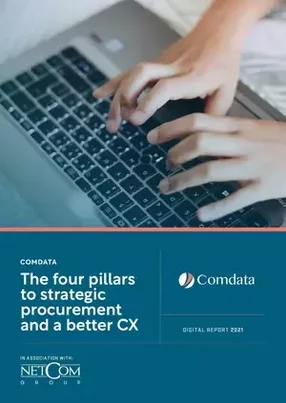The four pillars to strategic procurement and a better CX
Comdata is a leading player in the customer journey, customer attention, and BPO services market with over thirty years in the industry. In the last five years, Comdata has experienced rapid growth through acquisitions in Europe, Latin America, and Africa. It now holds a presence in 21 countries across three different continents, with about 500 customers globally, 600 million customer interactions per year, and more than 50,000 employees.
Last year, for the first time, Comdata was included in the Gartner Quadrants as one of the top players in BPO services. I sat down with their Group Chief Procurement Officer, Javier Baranda, to discuss Comdata’s procurement transformation journey and how they drive customer value through strategic procurement.
“I started at Comdata about two years ago, after receiving an attractive project challenge. The CEO had a clear vision of how they wanted to leverage procurement to better support the business. And that, honestly, was music to my ears. I have seen in business units, companies, different organisations, different mindsets that believe procurement is purely an administrative function. After 20 years in procurement, I am convinced that procurement has much more to add than just placing orders.”
The shift; from transactional to strategic procurement
“This project allowed me to offer a model that could help combat costly transactional procurement habits and to leverage the strategic procurement concept. In the beginning, I saw that each region had a strong focus on administrative tasks. It was blended with facility services, but in the end, probably 80% of the time was dedicated to facilities and only maybe 20% to procurement. And at least 30%, the vast majority of which was spent placing orders, resolving incidents with suppliers, etcetera. There was, generally speaking, very little focus on the generation of efficiencies for the company.
“It was a very standard policy. You get three proposals, you choose the best one out of the three, and that's it. I wanted to implement a much more strategic ‘out of the box’ model in which procurement was leading innovation, heading discussions with stakeholders to present alternatives solutions, questioning things, and ensuring the right decisions were being made for the company and its customers.
“I also wanted to insert more knowledge about how to negotiate more strategically with our vendors. We started with our most critical contracts to see what we could do differently, such as aggregating and anticipating needs, improved planning and negotiation requirements. As soon as we were able to deliver tangible results with tangible savings, which is the most visible of procurement outcomes, the organisation realised that procurement could be a partner in not only executing purchases but optimising the budget. In the end, my objective was not to buy cheaper but to buy better and maximise the value of the business.”
The Four Pillars of Procurement
The journey Baranda is implementing is based on four pillars. “The first pillar is the procurement role itself and how we demonstrate that we can contribute much more than simply placing orders. That means also gaining a seat at the table of key decisions, being very close to the executive committee and presenting and even championing viable alternatives that can drive cost efficiencies. This redefinition of the role needs to be sustained on a new organisational model, including a talent upgrade to become a reference for the business in the different categories of spend.”
The second pillar is governance. In order to effect change, people must understand when and how to engage with procurement. Setting clear policies and procedures helps facilitate, in the first instance, the communication with Procurement and, as a consequence, enables the mindset change of the organisation towards cost efficiency and, generally speaking, “value for money”. This helps increase “spend under management, and thus the opportunities to generate value for the company, and the decision-making process.”
“Systems are paramount for an effective governance, providing visibility in the spend, transparency and traceability of the procurement management, but also an additional efficiency to the end to end process.”
Akin to internal PR, the third pillar is the alignment with the business and its goals, ensuring internal stakeholders see procurement as a true partner. They can effectively and easily engage with procurement beyond policy requirements. “It’s important to avoid the perception that procurement will bog down the process or that it’s simply a box-ticking exercise. Stakeholders shouldn’t feel they need to convince or mobilise procurement to get what they need. Procurement needs to be a willing, proactive partner who will help them in terms of agility and innovation. We will bring ideas from new suppliers, and we will optimise outcomes. My objective is not to lead their business but to help them run their business better. “
The fourth pillar is monitoring and reporting. “When I started in this project, we weren’t yet monitoring savings or spend by supplier or category. So we are building that framework on how we report spend and performance. That also allows us to benchmark across different regions, see, for instance, who is investing more in IT versus services and identify potential opportunities.”
These four pillars, role, governance, alignment with the business and monitoring and reporting, are the foundation of Comdata’s procurement transformation.
Leveraging AI for a better CX
“Today, one of the main challenges of any industry is customer loyalty. Society has evolved in how we interact with companies or suppliers, especially in industries like retail banking, telcos, insurance. All these companies are facing a situation in which their customers have access to social networks where they share their opinions and experiences. The customer’s voice has been amplified, presenting both an opportunity and a risk. If you perform poorly with a customer, it no longer stays between you and the customer.”
Baranda says cost also remains a constant challenge. With increased competition comes increased pressures to reduce costs, and so Comdata must assist their clients in finding efficiencies and improving internal processes. “We need to help our customers enhance customer interactions, as well as improve the efficiency and cost. Comdata aims to achieve excellence in helping our customers to impart company values and improve customer retention. With the evolution of customer interactions through different channels, more and more, we are able to better serve our customers.”
AI is one of the technologies that Comdata is leveraging in this area, developing analytics to better understand the needs of customers and better manage perceptions.
“When a customer calls you, how is this customer feeling? How can I make them feel better? How can I help them better understand the situation? What previous interactions have we had with this customer, and how were those experiences? What are the customer’s interests? It’s that sort of analysis and modelling that AI can provide that is extremely helpful in ensuring our customers feel they are listened to and understood. We need to make our interactions more relevant, more efficient, more effective, and for that, artificial intelligence is massively important.”
A deeply embedded culture
It may sound cliche, but Comdata’s values are excellence, a strong customer focus, and innovation. In truth, however, it is much more than a cliche and is deeply embedded in the way they work and is evident at every level of the organisation. “We push ourselves not to take things for granted, to revisit old processes for potential improvement opportunities, to challenge mindsets and drive innovation. Our CEO has a very entrepreneurial mindset and is always challenging us to bring innovation. We want to be bigger, but we want to be bigger together, and with the participation of everyone.”
“We also have some initiatives where we contribute to the social environment in different countries, and we share and celebrate these things. It's a culture that brings people together and creates a sense of belonging and a sense of pride for what we do. We hold great pride in the fact that we are helping to build a company that every year brings increased value to its customers. And I love that approach, and I am personally very aligned with working collaboratively, seeking excellence, listening to others and remaining focused on our ultimate goal of always finding better ways to service our customers, together.”




